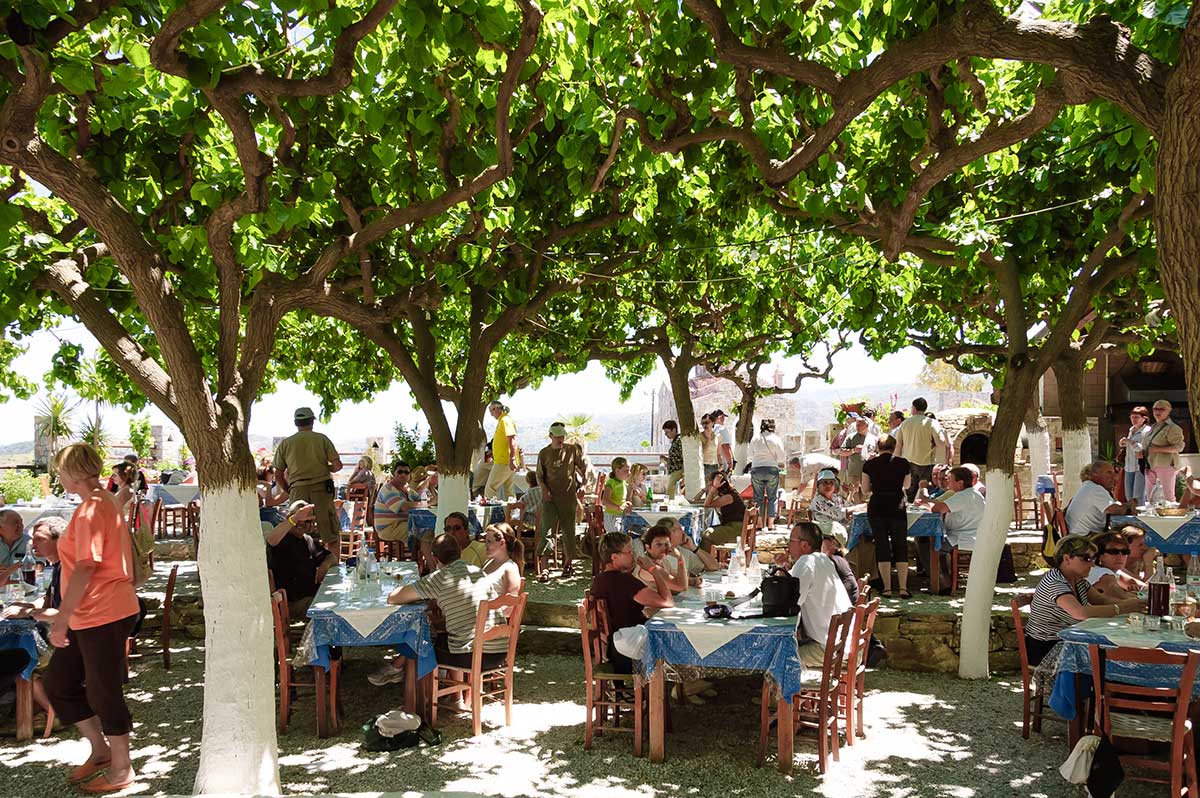When you choose Fodele Beach & Water Park Holiday Resort as your Cretan vacation destination, naturally, the first village you should visit is Fodele, which is six minutes by car inland.
Fodele Village
Fodele is a lovely traditional village with plenty of souvenir shopping and dining opportunities. You will find many pretty things to take home, including Cretan lace (kopaneli) and embroideries, icons, and much more. Also, try their orange preserves – the village hosts an orange festival every spring, celebrating the beloved citrus trees that grow abundantly in the region.
A river traverses the village, making it a pleasant oasis even in the summer, when the generous greenery provides shade and a lovely natural park to walk to if you feel so inclined. Famous as the birthplace of El Greco, Fodele boasts a museum dedicated to the beloved Cretan painter.
Other local attractions include the Byzantine Church of Panagia (Annunciation of the Virgin Mary), the Monastery of Agios Panteleimon (about four kilometers outside the village), the Monastery of Savvathiana, three Ottoman towers Kelia Koules (above Fodele Beach), Kokkinos Pirgos (on a hill towards the deserted Achlada village), and Kastelos Koules. You can also hike the Santorinios Gorge, south of Fodele, close to Marathos.
Marathos Village
Marathos is a mountain village at an altitude of about 400 meters above sea level inland Crete. The settlement takes its name from the Marathianos River, which flows nearby all the way to the beach of Fodele. It is just a 20-minute drive from Fodele Beach & Water Park Holiday Resort and worth visiting for its taverna, beautiful nature, trails, historical landmarks, and other unique attractions. Here are some highlights:
- Art Space of Maratos – Yiannis Klinakis Collection: It opened in 2009 and features mainly works by Marathos-native sculptor Yiannis Klinakis, born in the village in 1938. There are also sculptures and paintings by other artists from Klinakis’s collection. A large part of the gallery features the sculptor’s artworks dedicated to the battles of Crete during the Greek Revolution (1821-1830).
- Memorial for the fallen and the National Resistance: Erected in 1985 by Yiannis Klinakis, can be seen on the main road in Marathos.
- Doxa Cave: Impressive small cavern, 463 meters above sea level, at Kaka Pila of Marathos. Just above the entrance of the cave, there is a small tavern serving traditional mountain fare. You can see signs leading to the spelunkers’ main attraction from there. The cave is small (about 50 meters long), old, and eroded, but it is still “alive” and continues to form magnificent speleothems – flowstones, stalactites, stalagmites, columns, and small helictites. Access to the cave is free, and you can rent torches from the Doxa Tavern; however, wear proper apparel to explore it.
- Mount Stroumboulas: Features excellent hiking routes, a scenic limestone plateau, and a pond formed in the winter due to rainfall. The landscape around the pond is reminiscent of African landscapes due to the reddish clays in the area. When you reach the peak of Stroumboulas, you can visit the Chapel of the Holy Cross and admire spellbinding views of Heraklion, Día Island, and the surrounding mountain ranges – Psiloritis and Talean Range. One of the hiking trails on Mount Stroumboulas takes you to the Doxa Plateau, where you can stop for a bite in a local tavern and visit the Doxa Cave.
- Arkalospilios Cave: Drive ten minutes from Marathos until you reach the quarry of Arkalokefalo, 15-20 minutes on foot, walking southwest from its entrance (where you can park your car). Rich vegetation hides the cave’s entrance, but you will spot it if you pay attention to the signs. The total length of the spelunking routes inside is about 150 meters. The cave is 545 meters above sea level in an area of rare natural beauty. Inside, you will explore six rooms with impressive speleothems. Note that after heavy rainfall, the cave might have muddy, slippery floors.
Tylissos Village
Tylissos is a quaint inland village known as the site of ancient Tylissus. You can still see the ruins of the Minoan town and peak sanctuary, which flourished between 1650-1450 BC because of its strategic position on the road leading to Knossos. The archeological site boasts three small Minoan mansions (or palaces): A, B, and C. Of the three, the best preserved is Mansion A, where you can still distinguish the floor plans, central courtyard, apartments, and warehouses. Mansion C had a main chamber, cistern, and aqueduct for water supply and sanitation.
The currently inhabited part of the village has several tavernas, shops, a gas station, a school, and churches. The Church of Christ the Savior (Sotiras Christos) in the village’s central square boasts an arcosolium with Arabic inscriptions and frescoes from the 14th century depicting scenes from the Life of the Virgin Mary. Outside of Tylissos, to the south, you will find the cavernous church of the Life-Giving Spring (Zoodohos Pigi) in an area rich in olive groves and vineyards.
Spelunkers can visit the Trapeza Cave at Tylissos (on Pirgos Hill). The cave boasts impressive columns, stalactites, and stalagmites. The cave was used as a place of worship during the Minoan Era – probably in connection with the nearby Minoan Peak Sanctuary of Pirgos – as confirmed by archeological finds, including figurines of people in worship positions. Hopefully, these villages and their attractions will inspire you to discover inland Crete, its nature, culture, and traditions.
